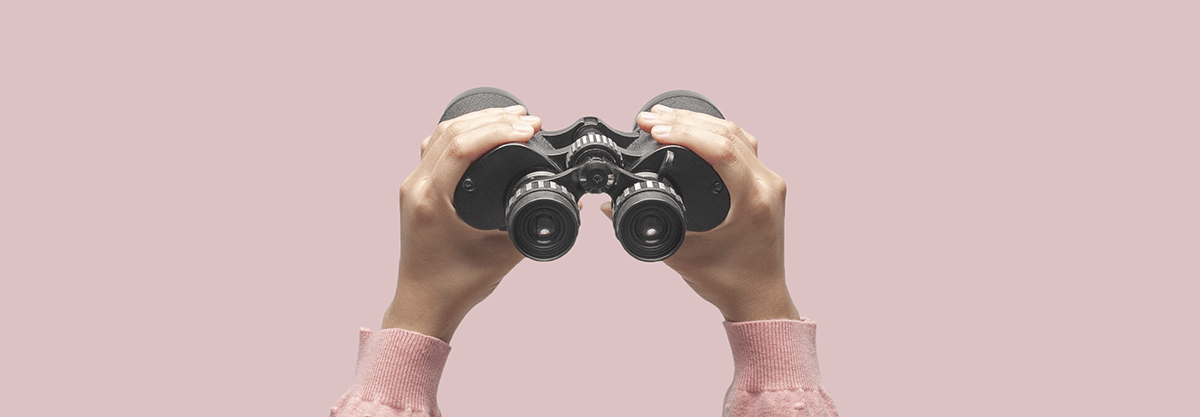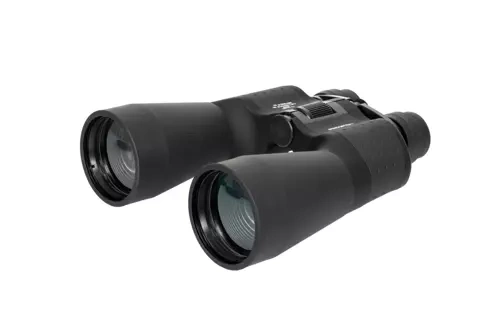How to choose binoculars? Guide for amateurs
Binoculars are very popular optical equipment that have many professional and amateur purposes. The main task of each binocular is to magnify and zoom the particular object we want to get a better look at. There are different types of binoculars with different parameters, and the choice of the right one depends mainly on the object we want to observe and the conditions in which we intend to do it. A different piece of equipment will work well for observing the night sky, and another during the day when we want to watch animals or insects. If you are wondering what kind of binoculars for observation will work for you, you must first identify its main use.
What are the types of binoculars?
Binoculars are mainly used for ground observation, and their utility is really quite diverse. For observation of birds and other animals by hunters, ornithologists and other nature researchers or private nature lovers. Special military binoculars are used by the army to watch the movements of the enemy, and astronomical binoculars are used to observe the stars. Binoculars are even used at mass events or in the theater. The design and parameters of binoculars depend on what their purpose is. So let's check out what the different types of binoculars are best used for.
- Astronomical binoculars
The ability to make astronomical observations is not only the domain of telescopes. Binoculars for astronomy also perform well in observing the sky. They can either be complementary equipment for advanced researchers or be the first device for basic observation for novice astronomers. Binoculars for astronomy are used mainly at night, so parameters such as image brightness, twilight factor, and exit pupil are important in them.
And what kind of binoculars to choose for astronomical observations? With an objective lens diameter of at least 50 mm. You will get even better views if you choose an objective lens diameter in the 70-100 mm range. Such astronomical binoculars will also be larger and heavier, but you can put it on a tripod, so the image stabilization will also improve. At night, the pupil of the human eye enlarges, so it is good to choose an exit pupil of 5-6 mm. With such binoculars you can observe the surface of the Moon or the passage of a comet, and under the right conditions you will even see brighter nebulae or star clusters.
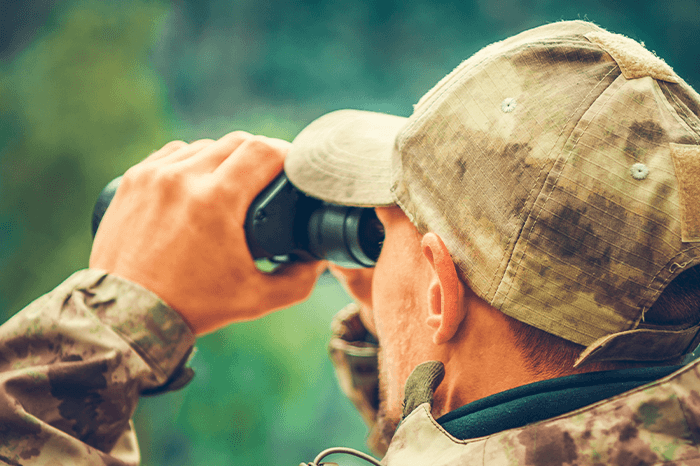
Binoculars are one of the basic elements of a hunter's equipment
- Roof prism binoculars
Every binocular uses a prism, thanks to which you get an un-reversed image. The type of prism primarily affects the size and price of the binoculars. Binoculars with a roof prism have lenses and eyepieces aligned, so they can be of smaller size than porro binoculars with the same specifications. There is also no risk of water and debris getting into the binoculars, or water starting to condense inside. Roof prism binoculars have only one external moving element, which is the focus knob, so there is no way for foreign bodies to get inside. This feature makes roof prism binoculars mainly used by specialists, such as military and ornithologists, whose equipment must always be reliable.
Such binoculars are up to twice as expensive as porro binoculars with the same specifications. Their manufacturers are forced to use expensive dielectric coatings to minimize light loss. Equally expensive are phase-correction coatings, contained, for example, in Bushnell binoculars. This coating avoids phase shift and improves contrast and image resolution. The solutions used in roof prism binoculars are expensive and this is the reason for the binoculars' prices, yet they are widely used. This is probably due to the fact that they are dirt-resistant compact models.
- Porro prism binoculars
Porro prism binoculars are also good quality devices that offer even greater image brightness and contrast than roof prism binoculars at the same price. There is virtually no light loss or phase shift in them. However, they have a moving eyepiece bridge, so they are less tight and larger in size. Above all, they are wider and there is a larger gap between the tubes, which makes them not very comfortable to hold with one hand.
- Hunting binoculars
The choice of binoculars for game observation depends on the part of the day. If a hunter goes hunting both during the day and at night, he will probably need two models of binoculars, with two different exit pupils and two zoom values. During the day, binoculars with smaller dimensions can be used. The objective lens diameter of the 35-42 mm range will be sufficient. The optimal magnification of binoculars is then 8 to 10 times. Of course, at night, observational conditions are difficult and a larger objective lens is needed. The optimal solution then is a hunting binocular with a lens diameter of 50 to 63 mm. Such a diameter already provides quite good image quality, and the size of the binoculars still allows them to be carried conveniently. When night hunting, night vision binoculars also work very well, which increases the chances of finding game and at the same time reduces the risk of making a mistake.
Which binoculars for wildlife viewing?
Binoculars for wildlife viewing can have similar parameters to those that a hunting binocular should have. Again, it is important to distinguish between binoculars used during the day and at night. If you are observing animals that take cover in a dark forest, a high contrast image is important. Seeing details of the animals' appearance, such as plumage colors, also depends on the brightness of the image. The objective lens diameter of the binocular of at least 35 mm is able to capture enough light to make the image rich in detail and color. For bird and wildlife observation, you don't need higher magnification at all either. A good minimum is 8x image magnification.
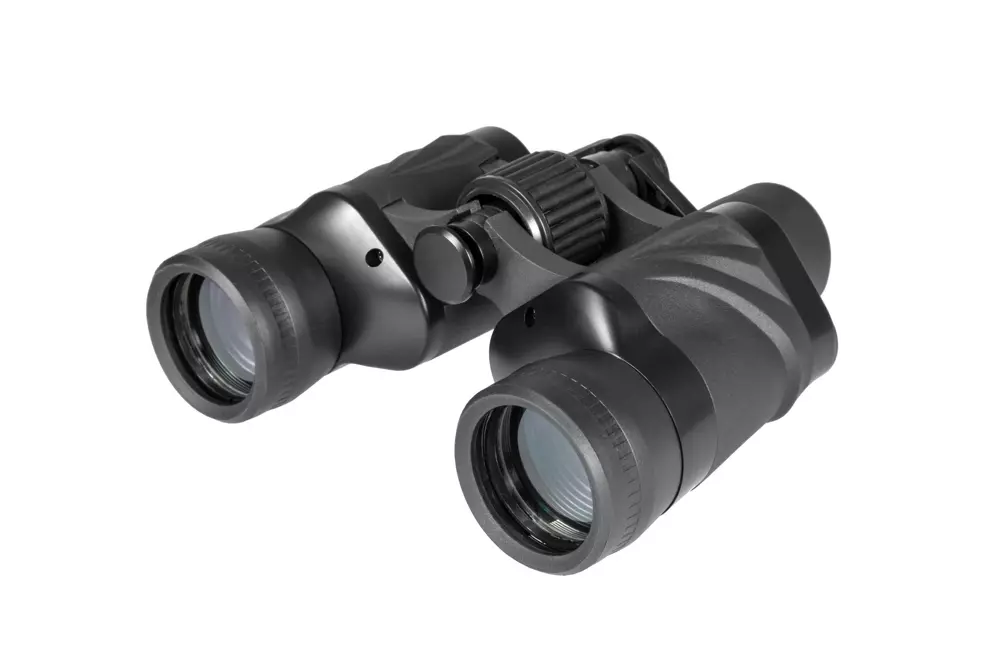
PROOPTIC 8x40 binoculars are an interesting choice for beginning observers
What else are binoculars used for?
Binoculars are also often used for recreational purposes, when no research or important observations are made with them. Usually the most important thing then is the binoculars' zoom, and getting a sharp image falls to the background. Binoculars can be used at horse races or in the theater or at a concert when you are sitting too far away and want to know what is happening on stage. Touring binoculars, on the other hand, will give you a better look at the city skyline. In the case of binoculars used for just such purposes, their size is very important. They should be small enough to fit into a backpack or handbag. It is best to choose compact models that weigh no more than 500 grams. A 3-8x image magnification and a lens with a diameter of 28-36 mm will also be sufficient.
What do binocular numbers mean?
Discussed above types and uses of binoculars still do not fully answer the question: which binoculars will be best for you? Although we have given the optimal parameters for each type of observation, individual factors are also involved. You need to get better acquainted with the individual parameters to really be able to choose the best equipment for you. Buying binoculars is not an easy task, but if you learn the most important terms, you will definitely be able to make a more deliberate decision.
- Binocular magnification
Binocular magnification is one of the most important parameters of binoculars, which tells us how many times an object or area will be zoomed in. Binoculars are usually specified by two values given at the same time, that is, magnification and lens diameter, e.g. 8 x 35. The first number tells us about the magnification value, and the second the diameter of the lens. In the example given, the object will be 8 times larger than if we were looking at it with the naked eye.
It might seem that the magnification should be as high as possible, but this is not the case at all. Magnification intensifies the trembling of our hands, which, after all, always occurs. The image ceases to be stable and it affects the quality of observation. In practice, binoculars with magnification greater than 12 x are rarely used. For higher magnification, additional stabilization of the image is needed, so placing the binoculars on a tripod. However, the use of tripods is the domain of telescopes, and we usually want to hold binoculars comfortably in our hands.
Lower magnification is also related to a sharper image, as well as a larger field of view, two very important features of binoculars. The magnification value also affects the diameter in the lens. The larger it is, the larger the diameter of the objective lens must be. Otherwise the image will be too dark and you will not see much in it.
- Binoculars with variable magnification
There are also binoculars available on the market with variable magnification, for example, 8-15 x 45. Such values show that you can magnify the image from 8 to 15 times, and this is usually done with a convenient knob. However, as you change the magnification, you will observe a decrease in the brightness and sharpness of the image at some point. Binoculars with variable magnification also have a more complicated design, which increases their risk of failure. Especially cheaper binoculars of this type break down more easily and can even damage your eyesight. So if you want to opt for such a solution, it is recommended to choose more expensive, but more proven equipment.
- Objective lens diameter
This is the second parameter, which is always given along with the magnification of the binoculars. In the case of the 8 x 35 binocular model, the diameter will be 35 mm. A larger diameter means that more light can enter the lens, so the image quality, sharpness and brightness will be better.
If we are already talking about choosing the optimal diameter of the lens, we can't help but mention the diameter of the pupil of the human eye, because it also determines the choice of the right size lens. As you probably know very well, our pupils have the ability to dilate and contract, which is related to the amount of light. If there is a lot of it, the diameter of the pupil will be about 2.5 mm, while in darkness the pupil usually expands to 7 mm. It is also worth remembering that this is an individual characteristic, and the ability of the diameter to enlarge decreases with age.
The exit pupil in binoculars should be within the diameter range in the pupil of the eye, so it should not be larger or smaller. Its choice also depends on the conditions in which we intend to use the binoculars. Binoculars used for daytime observation should have a smaller exit pupil than binoculars you plan to use at night.
To calculate the exit pupil, divide the diameter in the lens by the magnification value. For daytime observation, a diameter of 2.5 mm will be sufficient, which is provided by binoculars with parameters of 10 x 25. At night, binoculars with a larger exit pupil will perform better, so for the same magnification we must already choose a larger binocular, for example, with objective lenses with a diameter of 50 mm.
When choosing the diameter of the lens, you must also remember that with it the price and dimensions of the binoculars also increase. A larger objective diameter is also required for higher magnification so that the brightness of the image does not deteriorate.
- Field of view
Field of view and angle of view are the same terms that define how large is an area we see through binoculars. They are given using two different parameters. Linear field of view tells us how many meters of a given area we will see if it is 1,000 meters away. Angular field of view, on the other hand, is given in degrees.
Yet another value is the apparent field of view and is calculated by multiplying the viewing angle by the magnification in the binoculars. The greater the apparent field of view, the larger the area you can see even at high magnification. If the value is 60 degrees or more, then we are already dealing with wide-angle binoculars. However, the general rule of thumb is that the lower the magnification a particular binocular has, the larger its field of view.
Other important elements and features of binoculars
Binoculars make it possible to observe objects far away from us, but any optical equipment can have imperfections that result from the laws of physics and, for example, how a beam of light is refracted in the lens. Special elements or additives are therefore used to eliminate these defects.
Aspheric lenses correct distortion and loss of image sharpness that occurs at the periphery of the field of view. In turn, anti-reflective coatings are used to improve light transmission and better color reproduction.
It is also worth paying attention to whether a particular binocular is waterproof. Conducting observations in the field always involves the risk of rain, which can get inside the housing and cause damages. If you're already buying binoculars, it's worth paying extra to be sure they'll perform well in all conditions. Some binoculars are even waterproof when fully submerged to a depth of 1 meter.
What binoculars to buy to be as multipurpose as possible?
An all-purpose binocular should certainly work both during the day and at night, should be lightweight and small, and allow you to observe a wide variety of objects, in all conditions. Of course, such a device does not exist, but you can choose binoculars that will come close to the ideal.
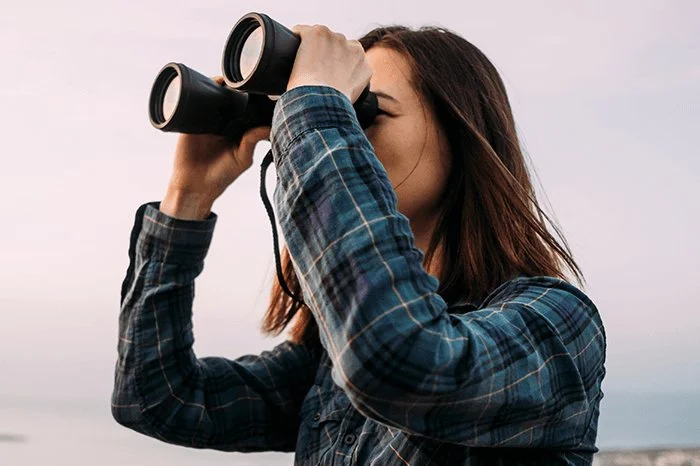
When choosing binoculars, think about the type of observation you intend to make
As you already know, the exit pupil is very important, and it is optimal to choose equipment with a pupil diameter of about 5 mm. It will allow you to make observations on a sunny day, in a dark forest and even at night. Such a diameter will already have binoculars with a lens diameter of 42 mm and 8x magnification. They are still lightweight and small, so they allow you to keep a stable image for longer. They also provide a fairly large field of view and good depth of focus. This is the equipment of choice even for professionals, so it should also work well for casual observing.
Binoculars - price of good quality equipment
You already know how to choose binoculars with the right parameters, but how much should it cost? The price range of binoculars is really wide. You may buy binoculars for as little as 40 pounds, or spend up to several thousand on them. The price increases with better parameters and modern solutions applied. Binoculars with a larger diameter and better field of view will be more expensive, but will allow you to conduct more advanced observations. Likewise, in roof prism binoculars it is possible to have better sealing, so water or microorganisms that can destroy coatings will not get inside, but you have to pay more for them. If you care about the binoculars being a purchase for years, it is worth investing in equipment that costs more than 40 pounds.
Once you have chosen a better quality and more expensive binocular, you will definitely want to take good care of it. To clean the optics, it is best to choose a special kit dedicated to this purpose. We do not recommend using wet wipes, toilet paper or paper towels, as they can easily scratch the glass and cause streaks. The optics cleaning kit includes a special ruber pear and cleaning liquids, the use of which is safe for delicate glasses. Binoculars should also be stored properly, and if you want to put them up, do it only on the lens mount.
Check out similar entries:
- Which binoculars for bird watching?
- Spotting scope vs Binoculars - which to choose?
- Astronomy for beginners



